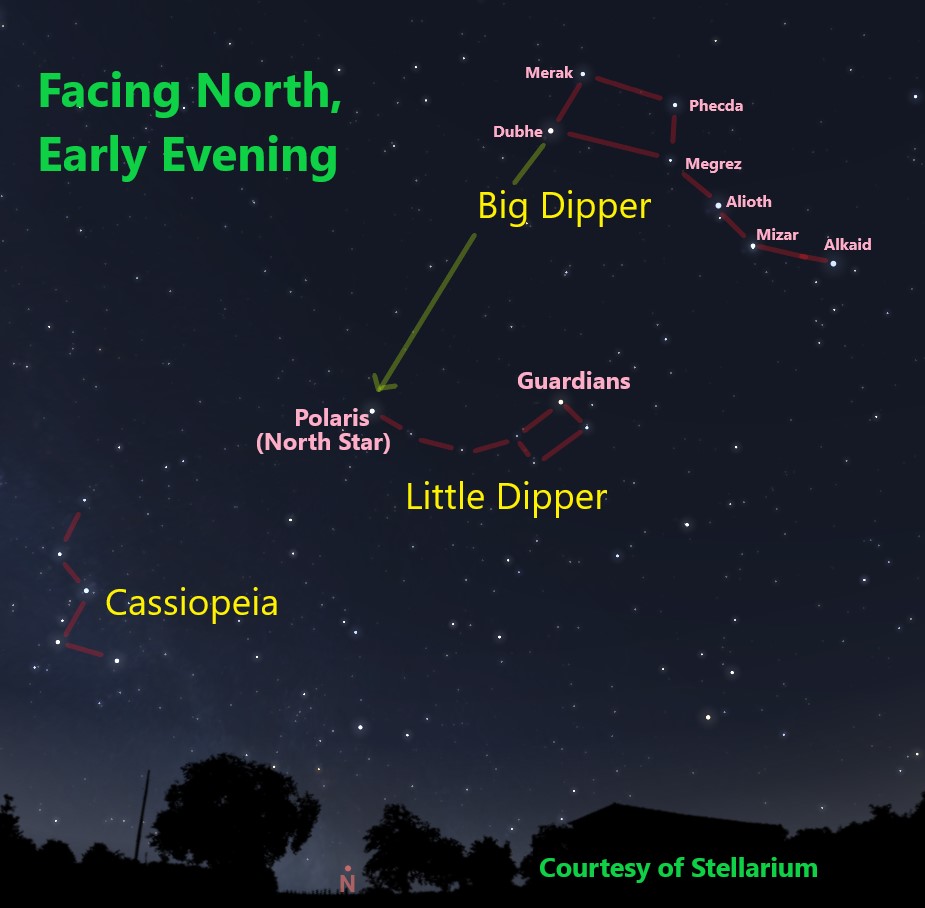DOUBLE DIPPING
Most people would say that either the Big Dipper or Orion are the most famous groups of stars in the night sky. Orion appears as its own constellation, portraying a hunter. It is disappearing into the west during the early evening in April. On the other hand, the Big Dipper is an asterism (star group) that is part of the huge, otherwise mostly dim constellation Ursa Major, the Great Bear. I have written about the bear before, in the July 2024 edition of this blog. It is located high in the sky during convenient evening hours during the spring.
Not everyone sees a dipper in the seven familiar seven stars shown below- to the British, it is the Plough or Charles’ Wain, while other cultures see it as a wagon or ladle. To the Micmac and Iroquois peoples, residing in northeastern North America, the Dipper represents seven hunters chasing and eventually killing and eating a bear. The skeleton is what is visible in the sky today. In Roman mythology, what we call the Big Dipper is actually the beautiful maiden Callisto. Like so many other unfortunate people, she was seduced by Jupiter, King of the Gods, and bore a son Arcas. Juno, Jupiter’s wife, was angered and transformed Callisto into a bear roaming the forest. One day Arcas, who had grown into a fine hunter, was greeted by his mother, who had forgotten that she was no longer in human form. He was about to unknowingly kill his mother, but the arrow was intercepted by Jupiter. He changed Arcas into a bear as well, and grabbed both by their tails, hurling them both into the sky, forming the constellations that we see today. Their tails are much longer than that of the average bear! Juno was still angry and changed the bears’ position in the sky, causing them to circle endlessly around the North Star, never dipping below the horizon, where they could get water.

The stars of the Big Dipper and the much dimmer Little Dipper are well seen on clear, dark April nights
The stars of the Big Dipper are mostly relatively bright at second magnitude and can be seen through moderate light pollution when high enough in the sky. Megrez, joining the bowl and handle, is quite a bit dimmer and can be hard to see. Only Polaris and the two Guardian stars are bright enough to be easily visible in the Little Dipper, if you are too close to the city. Bring binoculars along or head out to a darker location to trace out the whole pattern, or if you want to try to trace out the entire Great Bear.
The star at the end of the handle of the Little Dipper is the famous North Star, Polaris. The so-called “Pointers,” the stars Dubhe and Merak, at the end of the Big Dipper’s bowl farthest from the handle, always point to the North Star. As is well known, Polaris is located almost directly above the North Pole of the Earth. This causes it to hold almost still while all of the stars in the northern half of the sky to appear to revolve around Polaris. Constellations like Ursa Major & Minor and Cassiopeia are circumpolar- close enough to the celestial pole that their circles are small enough that they remain mostly or entirely above the horizon year-round, although they get quite low when passing under the North Star. As you can see, Cassiopeia, whose distinctive “W” or “M” shape stands out well when high in the sky during the fall and winter, is quite low at this time of year. It may be hard to spot unless you have a fairly dark site or binoculars. Notice how Cassiopeia is always on the opposite side of the North Star from the Big Dipper.
Five out of the seven stars in the Big Dipper, plus a number of others in the sky, are part of the Ursa Major Association. Astronomers believe that they are relatively young stars, having formed together a relatively recent 300 million years ago. They are all roughly 80 light years from Earth, while Dubhe and Alkaid are quite a bit farther away, merely appearing in the same direction.
Don’t miss our Gateway to the Stars programs, scheduled for May 10, June 7, July 5, August 2, September 27, and October 25. A guest speaker or Park Ranger led talk will precede free telescope viewing on our Entrance Plaza. See the Park website, www.nps.gov/jeff for more information.
